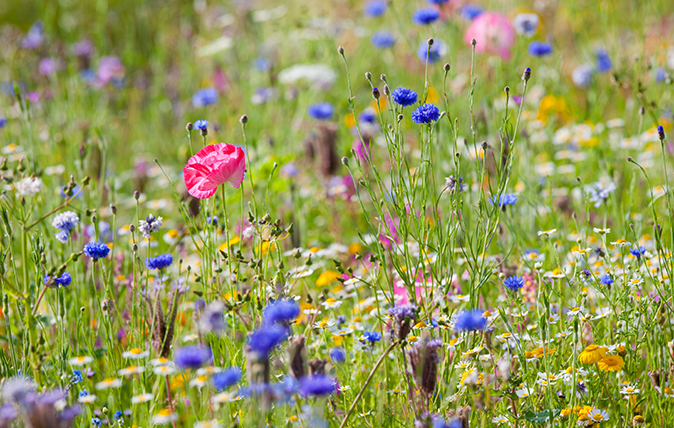My 40-year odyssey turning a field into a wildflower meadow that's a buzzing, humming, fluttering world
Country Life columnist Agromenes started turning a field from intensive agriculture to wild flowers four decades ago — a decision which has been proven spectacularly worthwhile.


It was one of those magical moments when, last week, the warm, but cloudy day burst into a golden evening and the sun broke through and shone on a meadow alive with the sound of 1,000 insects. It’s taken us nearly 40 years fully to recover this natural beauty.
Once doused to death with nitrogen and pesticides, the field produced its last crop of rape in the 1980s, when Agromenes’s particularly bad bout of asthma sealed its fate. Left to itself, it took years to lose its unnatural fertility and build up from its depleted biodiversity, but, gradually, an increasing variety of wildflowers and grasses began to emerge.
"This is a buzzing, humming, fluttering world, noisy and alive now that chemical sterility is nearly four decades away. Nature is always ready to reclaim its own"
There were, of course, several seasons of thistle pulling and a continual war on bramble encroachment, as well as the careful removal and replanting of oak saplings now flourishing elsewhere. The meadow has been allowed to grow wild without our scattering new seeds, but it’s not been left entirely to its own devices — simple rewilding would have meant that the bully plants would have taken over.
The result is that, earlier this year, we sat in the spring sunshine, surrounded by buttercups as small children raced through the meadow paths, hardly taller than the mass of yellow flowers. Then came the ox-eye daisies — so rare last year, but everywhere this.
Now, the bounty of summer — every part of the field a mixture — loosestrife and hairy vetch, pyramid and bee orchids, cornflower and ragged robin, self heal and corydalis, carried here by birds or emerging from the now-recovered soil. And the noise: the crickets, the birdsong and the buzz of myriad insects. More butterflies than ever and all sorts of flying and jumping insects whose names I’ve still got to learn.
This is a buzzing, humming, fluttering world, noisy and alive now that chemical sterility is nearly four decades away. Nature is always ready to reclaim its own.
It is a threatened world, however, and not only because this is a fecund oasis in what is still largely an industrially farmed landscape. It is also under siege from the changes in our climate.
Exquisite houses, the beauty of Nature, and how to get the most from your life, straight to your inbox.
"The rapidity of the effects of global heating gives no time for evolution"
This week, new research, based upon the most extensive survey ever, detailed the effect of warmer weather on bees, our most important pollinators. It examined 88 species of wild bees over a period of 40 years — close to the lifetime of our meadow. Researchers used more than 350,000 individual recordings to show that the bees are emerging at earlier times because of the heat, which means that their emergence doesn’t correspond with the flowering of the plants on which they live.
The rapidity of the effects of global heating gives no time for evolution and the mismatch of insect and food will increase the depletion of bees and hoverflies, which was noted in the 2019 report from the Centre for Ecology and Hydrology. It showed that, between 1980 and 2013, every square kilometre lost an average of 11 species.
The growing movement for regenerative farming will, of course, help the recovery in numbers. That’s essential, as pollination by bees is worth £700 million a year in this country and only one-third is achieved by honey bees — wild bees effect the rest.
However, the mismatch of the emergence of bees with that of blossom, as well as the increase in heat and more intense rainfall, presents the countryside with outcomes wholly different from anything with which it has had to deal before. There’s little we can do about the changes already in the pipeline except to speed the search for variety. The wider the range of plant varieties, the bigger the number of plant species and the more extensive the protection of rare examples, the greater is Nature’s capacity to deal with significant climate change.

A simple guide to the wildflowers of Britain
At long last Spring seems to be here — and with it, the natural flora that give so much pleasure.

Visit the best wildflower meadows in the UK
The Wildlife Trusts recommends their top 40 wildflower meadows around the country
Country Life is unlike any other magazine: the only glossy weekly on the newsstand and the only magazine that has been guest-edited by His Majesty The King not once, but twice. It is a celebration of modern rural life and all its diverse joys and pleasures — that was first published in Queen Victoria's Diamond Jubilee year. Our eclectic mixture of witty and informative content — from the most up-to-date property news and commentary and a coveted glimpse inside some of the UK's best houses and gardens, to gardening, the arts and interior design, written by experts in their field — still cannot be found in print or online, anywhere else.
